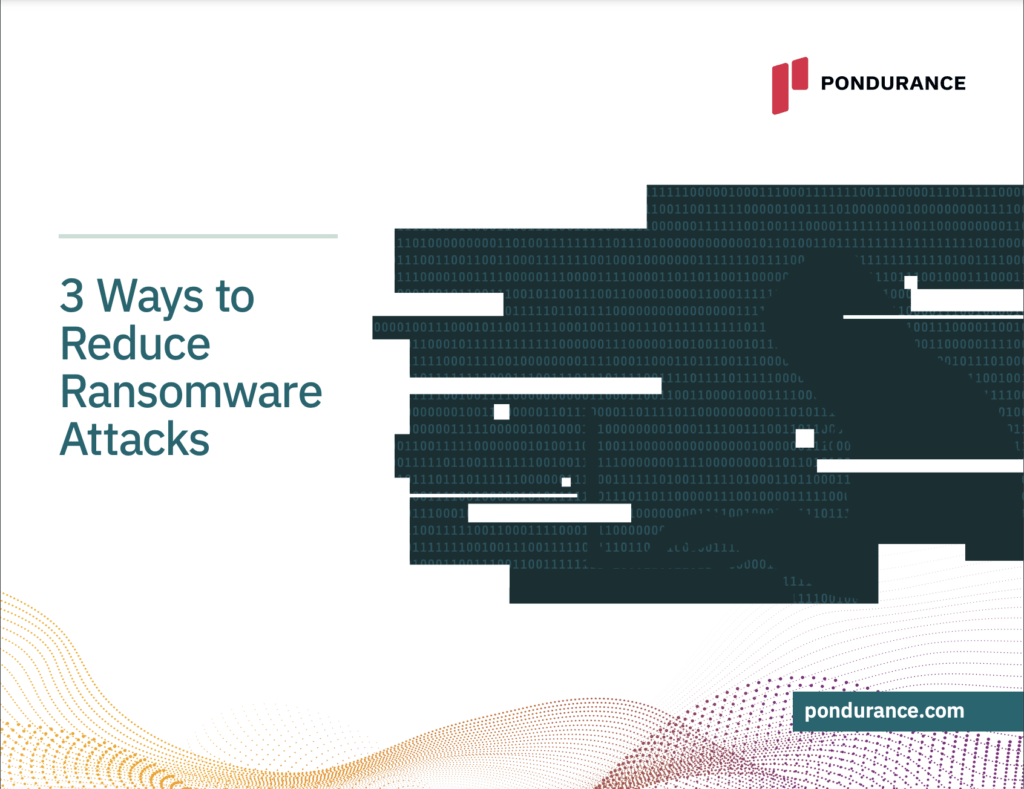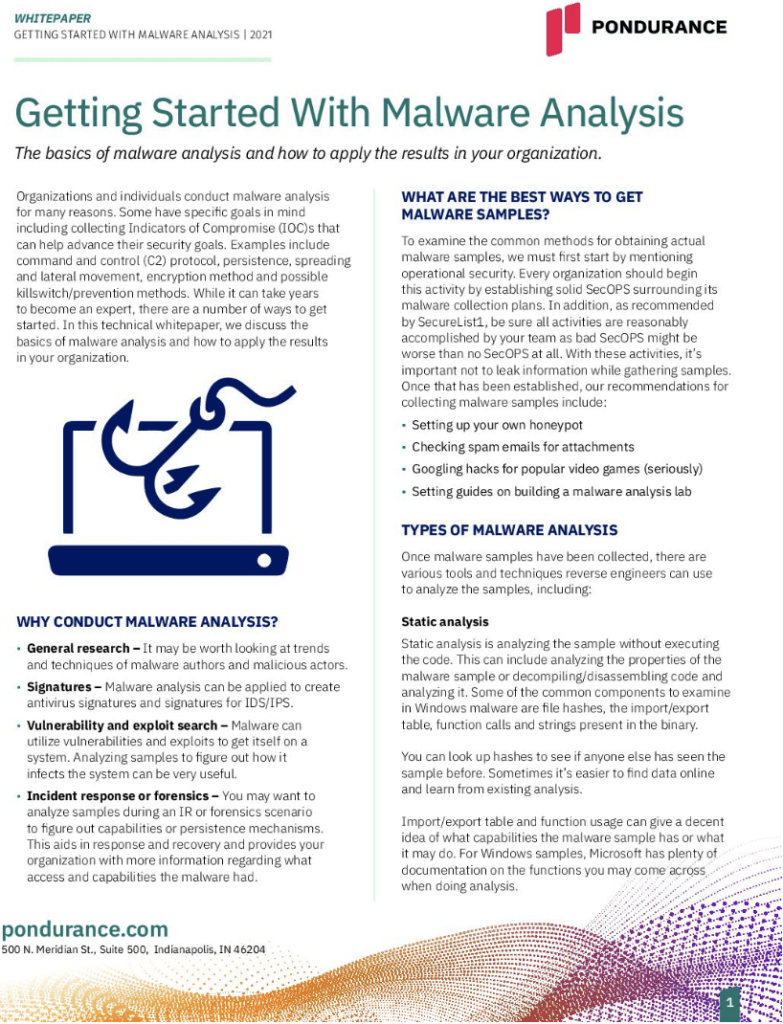Our privacy policy is located here.
Common Attack Vectors
And Keys to Protecting Your Business
Ransomware
- Keep all computers and devices patched
- Enable MFA
- Limit user access
- Allow only authorized applications
- Use network segmentation
- Limit remote access as much as possible
- Establish 360-degree visibility
- Monitor and analyze logs
- Provide consistent security awareness training
- Encrypt endpoints
Identify. Prioritize. Protect.
Malware
- Install reputable antivirus software and ensure it remains up to date
- Regularly update your operating system and all installed applications
- Enable built-in firewalls on your devices
- Be cautious of email attachments and links from unknown sources
- Utilize strong passwords and enable multifactor authentication (MFA) where possible
- Create regular backups of your important files and store them securely offsite
- Employee training – Educate staff members about potential threats such as phishing emails and social engineering tactics employed by cybercriminals
- Network segmentation – Divide your organization’s network into separate zones to minimize the spread of malware should an attack occur
- Vulnerability management – Regularly assess, identify, and remediate vulnerabilities in your IT infrastructure before they can be exploited by attackers
- Incident response planning – Develop a well-defined incident response plan outlining roles, responsibilities, and procedures to follow when faced with a security breach
Phishing
Additional Phishing Resources
Spear Phishing
Additional Spear Phishing Resources
Business Email Compromise (BEC)
Additional BEC Resources
Cyber Risk
Cyber risk, an ever-growing concern in the digital landscape, poses significant threats to organizations of all sizes. According to the National Institute of Standards and Technology (NIST), cyber risk encompasses the potential for loss or harm related to technical infrastructure or technology use within an organization. It spans a wide spectrum of risks, from data breaches and hacking to cyber espionage and terrorism, each capable of causing extensive financial, reputational, and operational damage.
Concrete examples of cyber risk illustrate the complexity of this issue. Unauthorized access to a company’s network can lead to the theft or corruption of sensitive information. Distributed Denial-of-Service (DDoS) attacks can disrupt online operations, resulting in significant losses. Phishing, a deceptive tactic employed by hackers, poses another common cyber risk, with high frequencies in both individual and corporate spheres.
It’s crucial to recognize the intrinsic link between cyber risk and cybersecurity. Cyber risk in cybersecurity denotes the vulnerability of an organizational network or system to breaches, attacks, or other IT-related threats. A robust cybersecurity strategy effectively reduces cyber risk, bolstering the organization’s defense against emerging threats.
Effectively mitigating cyber risks necessitates a specialized approach, often provided by dedicated cyber risk companies. Industry leaders like Pondurance excel in identifying and managing cyber risk, offering tailored solutions to meet the organization’s specific needs. Through advanced technology, strategic planning, and industry expertise, Pondurance enhances the cyber resilience of organizations.
Insurance serves as a viable option to mitigate the potential damage caused by cyber risks. Cyber risk insurance has become indispensable for businesses, covering costs such as data restoration, system repair, and legal consequences arising from cyber incidents.
Pondurance, as an industry leader, not only offers top-tier tech solutions but also provides guidance in the critical domain of cyber risk insurance. Leveraging their expertise, organizations can navigate the complexities of insurance, ensuring coverage aligns with their specific cyber risk profile.
In conclusion, cyber risk poses significant threats to organizations, necessitating proactive measures to integrate it into overall risk management strategies. Education, understanding, and the expertise of cyber risk companies, alongside comprehensive cyber risk insurance, are crucial components of effective cyber risk mitigation and management strategies.
Mechanics of Cyber Risk Management
The mechanics of cyber risk management are indispensable in contemporary business practices, given the pervasive influence of digital technologies across sectors. Organizations must grasp, assess, and mitigate cyber threats to safeguard their technical infrastructure, technology usage, and reputation from digital attacks.
The types of cyber risks vary significantly depending on the intricacies of an organization’s digital presence. They encompass threats to data integrity and protection from breaches, disruptions to system availability caused by malicious attacks like DDoS, and damage to reputation due to incidents of cyber fraud or data misuse. The financial implications of these risks underscore the crucial need for cyber risk insurance, providing a financial safety net against potential losses.
Pondurance emerges as a leading figure amidst industry challenges, with its outstanding efforts in identifying and countering cyber risks. The credibility of Pondurance and its diverse methodologies empower organizations to analyze and defend against the proliferation of cyber attacks effectively.
Understanding the mechanics of cyber risk management entails delving into unique strategies and processes. Cyber risk assessments play a pivotal role in this regard, involving the identification of critical business functions and digital assets, vulnerabilities in the system, potential threats, and the impact of their materialization. Addressing these risks with calculated solutions leads to the implementation of targeted safeguards.
It’s essential to view risk assessments as an ongoing aspect of cybersecurity programs. Pondurance adopts a risk-based approach, conducting regular assessments to document risk reduction over time. By operationalizing risk assessments into their cybersecurity programs, Pondurance clients can adapt to the evolving cyber risk landscape and adjust their strategies accordingly.
Integrating this process into a comprehensive framework enhances cyber risk management efficacy, enabling organizations to navigate the dynamic threat landscape. A risk-based cybersecurity approach fortifies this framework, promoting stability, reducing risk occurrence probabilities, and maintaining a resolution-focused outlook. The symbiotic relationship between managing cyber risks and risk-based cybersecurity is indispensable for ensuring a secure digital future for all organizations.
Importance of Cyber Risk Management in Today's World
In the hyper-digitalized environment that characterizes today’s world, the importance of cyber risk management cannot be overemphasized. Wading through the murky waters of contemporary cyberspace, business entities and individuals alike face diverse forms of digital threats that underline the essential role of a potent cyber risk framework. Cyber risk, a term synonymous with threats associated with the digital realm, spans multiple classifications from potential data breaches, to sophisticated cyber-attacks targeting overarching digital infrastructure. Understanding these risks and fostering apt approaches to mitigating them is paramount to secure digital operations.
Firms like Pondurance have been at the forefront in the provision of comprehensive cyber risk management solutions, underpinning the security of vulnerable digital landscapes. A robust architecture for managing cyber risk is a vital cog for organizations, helping to prevent, detect, and respond to diverse cyber threats. Crucially, it can shield the organization from potential financial losses and reputation damage, establish client trust and regulatory compliance, and provide the assurance of operational continuity.
Dovetailing this is the subject of cyber risk insurance, a crucial consideration as organizations grapple with the potentially crippling financial implications of a cyberattack. Despite the most stringent cyber risk controls, the volatile and evolving nature of cyber threats entails a perpetual element of risk, which justifies the need for an underpinning insurance layer.
In the bid to up-skill and equip relevant stakeholders and organizations with the necessary competency for navigating the risk-laden digital waters, cyber risk management certification programs have become increasingly popular. These certifications offer necessary training for identifying, analyzing, and executing risk-response strategies, thereby empowering a cyber risk manager to safeguard the organization’s digital assets effectively.
Independent bodies like the Cyber Risk Alliance offer resources and collaborative platforms for professionals in the field. The alliance facilitates deeper understanding, sharing of best practices and strategies, and enhancing the overall digital security posture.
Undoubtedly, the importance of cyber risk management in today’s world cannot be understated, given the global, pervasive, and destructive nature of cyber threats. Importantly, entities such as Pondurance continue to play a pivotal role in making the digital world a safer place to explore, work, and live. This, in essence, captures the crux of cyber risk management.
The Role of Cyber Risk Insurance
In the epoch of digitalization and the escalating reliance on technology, cyber risk has grown into a significant factor every enterprise needs to consider. The rarity of a business remaining unscathed by cyber threats signifies the universal vulnerability to potential assaults, ranging from sensitive information leaks to significant financial losses. This is where cyber risk insurance plays a critical part in the risk management strategy of businesses.
Cyber risk insurance, sometimes referred to as cyber risk and insurance, is essentially a protective measure against the financial losses that result from cybercrimes. With an escalating rate of such incidents, businesses are increasingly finding value in procuring this line of insurance. It’s crucial to delve deeper into the role of cyber risk insurance, to fully appreciate its impact.
Foundational to this coverage is the understanding that it provides an economic safety net against an extensive array of cyber risks. Whether a company is combating system outages, ransomware attacks, theft of intellectual property or customer-related litigation resulting from data breaches, insurance cyber risk is definitively a tool in the financial risk management toolbox.
With the increase of cyber risk insurance companies looking for cybersecurity partners to help their clients in times of a breach or in proactive prevention, Pondurance has become a trusted cybersecurity provider. What sets Pondurance apart is not just their ability to identify and mitigate the risks but their commitment towards strengthening their clients’ prevention mechanisms.
As the landscape of cyber threats intensifies in complexity, the cyber risk insurance coverage becomes all the more critical. Companies such as Pondurance play a significant role in not just managing these risks but also in fortifying organizations’ resilience towards potential cyber onslaughts.
In conclusion, the role of cyber risk insurance in today’s digital business world is indispensable. As cyber threats continue to evolve in sophistication, so does the need for robust, versatile insurance that can assist an organization in bouncing back after a cyber incident. A comprehensive cybersecurity strategy coupled with cyber risk insurance enhances the resiliency of a business and ultimately aligns with its goal of sustainable growth.

